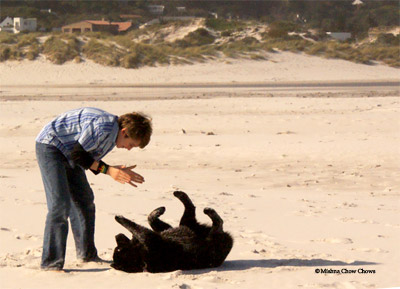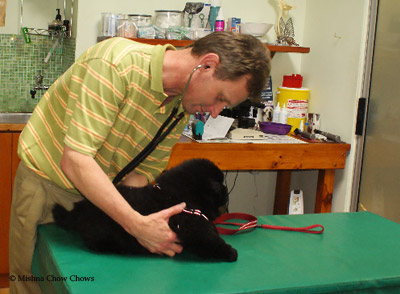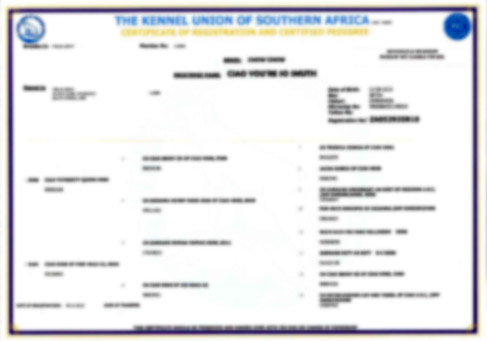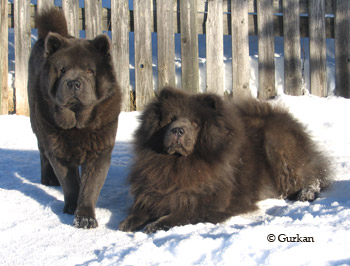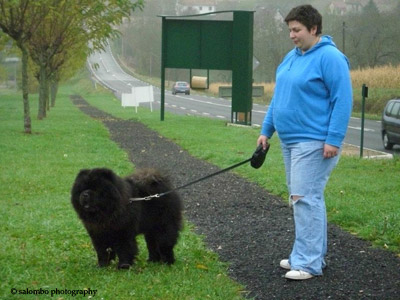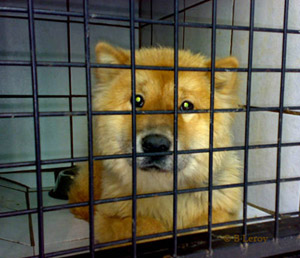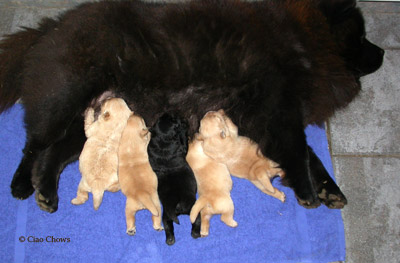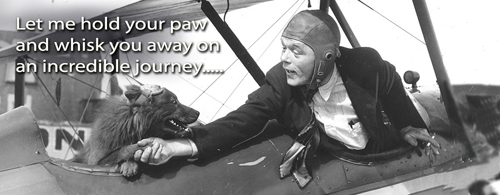Chow Chow Africa guides
Grooming and Feeding of the Chow Chow

What drew you to the Chow Chow's look initially? One of the most likely things was the magnificent coat - rough or smooth - shiny, offstanding, impressive!
Known for it's 'clean' smell and habits, the Chow Chow does not enjoy being unkempt, it enjoys 'strutting' around once it has had it's regular groom and/or bath! An Arctic breed of origin, it's double coat demands particular diets and certain skin care regimens to ensure good skin and hair, health and condition.
Grooming
the Chow Chow:
Maintaining the Chow coat is not difficult provided
it is done REGULARLY. It has
straight hair which is relatively easy to brush, but if left too
long, the soft undercoat gets tangled and
knotted, making your job in brushing very difficult, besides being
most uncomfortable for the Chow!
The puppy should be brushed on a daily basis, mostly to get it familiar with the routine. Start when it is tired and sleepy. Brush it gently whilst using the time to bond with it. Once in it's adult coat, you can maintain the coat with a thorough brush once a week. This is a task best left to one person in the family.
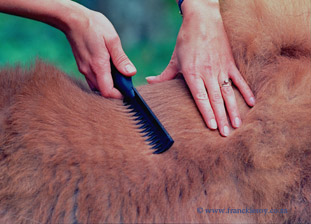 The advice below is given for both smooth and rough Chow coats. Both coats moult and both
coats require regular maintenance. However, the smooth is admittedly
far less work than the rough.
The advice below is given for both smooth and rough Chow coats. Both coats moult and both
coats require regular maintenance. However, the smooth is admittedly
far less work than the rough.
Tools you will need are pinbrush, slicker brush, medium/coarse comb, nailclipper, soft cloth, pair of scissors. During moulting times, you may find a rake very useful to remove excess hair. Where possible, brushing can be replaced by weekly blowing with an air dryer (similar to a human blowdryer but with very mild heat settings so as not to damage hair/skin). Blowing right down to the skin removes debris, is gentler on the skin and is easier for the human. Commercial dog hair dryers are avaialble online.
For brushing: Quietly lie the Chow on it's side for grooming. (If you are using a grooming table, make sure that you have a non-skid mat on it.) Start at the shoulders, working towards the rear. Hold the hair back with your one hand and comb forward small amounts at a time. Make it short strokes down to the skin. (If you only brush the top part of the coat, the undercoat mats underneath and eventually becomes a 'breeding place' for all kinds of skin trouble!!) Continue brushing to the skin all over the whole dog. Then turn it over on to the other side, repeating the process. Whilst the dog is on it's side, you can cut excess hair under the feet (around the pads), and trim the nails when necessary. Make sure the eyes are clean and use a flea-comb for the muzzle. Sitting it up, brush out the chest and mane. Standing the dog, do the 'breeches', also cleaning up around the anus. Do the tail now, working from the base, brushing down and around.
For blowing: If your Chow is not used to the dryer noise, first gently socialise the dog to be accustomed to being blown with a dryer. Then blow them all over the body, making sure the blower parts the hair to the skin and removes sand and debris under the tail. Be gentle around the face and do not blow into the ear. Dry face and between toes with a towel if the dog objects to being blow dried in these areas.
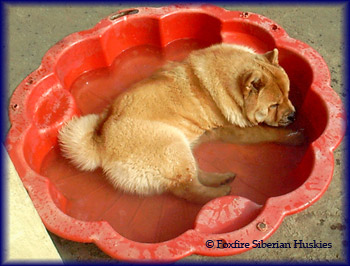
Shaving
the Chow Chow:
It is one of the most misguided concepts, thinking that
you are doing your Chow Chow a favour in shaving it!
The opposite is true, and if you are totally honest, you're
probably doing it to save yourself work! If this is the
case, please buy yourself a smooth Chow next time.
It is pointless buying a rough Chow for it's long coat,
only to shave it short like a smooth. But there are far
more serious implications.
Think back of China/Tibet where the breed has spent
thousands of years: The winters are bitterly cold, but
the summers can be excessively hot. The Chow Chow
is well adapted to these extremes. Being a
double-coated breed, sheds it's undercoat when it
is too hot. Thus nature protects the dog from being
too hot, whilst retaining the outer coat (thick, shiny
guard hairs) to protect it's very light coloured skin.
When shaven, it is the undercoat (that which keeps the dog warm and waterproof) which grows back first!! This means that your Chow will be hotter than ever! It will have no protection for it's skin because the coarse outercoat is also gone! To add injury to insult, we have received numerous reports where the Chow was shaven, and the lovely shiny outer coat never grows back.
We urge you to be realistic. The magnificence of the rough coated Chow only is so because it has been given much time and attention. Very few folks who see the rough coated show Chow in it's perfectly groomed state, realise that it has taken hours of work on that day, to get it that beautiful! Not to mention the weeks/months beforehand! Whilst the rough coated Chow as a pet or at home will not need the same many hours of daily grooming as the rough show Chow, it still requires at least 1 hour of your time, at least once a week. If you find coat maintenance a problem, we recommend you choose a smooth Chow Chow. You have all the benefits of owning a Chow, without the amount of work required to maintain the coat, as grooming the smooth Chow is done the same as a rough, but it goes much quicker, and can be done less often.

Bathing
the Chow Chow:
Although the Chow does not develop that distinct
'doggy' odour after not being bathed for some time,
it still makes for easier coat maintenance and healthier
coats to bath your Chow about once a month.
Let us stress the importance of using shampoos
formulated for dog skins!! The dog's skin is not
nearly as thick or acidic as the human skin, and
any soap/shampoo not formulated for their skin,
will dry it out and make it a paradise for parasites & other nasties! The Chow's reknown sensitive
skin makes this a necessity to avoid all kinds of vet
bills in time.
When bathing, make sure the coat is thoroughly wet down to the skin. Apply shampoo and work it through coat. Rinse THOROUGHLY. Then apply a DOG conditioner (for the same reasons stated above - please use a conditioner formulated for dog skins, not human or other products). Rub it in well and then rinse it out THOROUGHLY.Allow the dog to shake itself a few times, then use large thick towels to dry it well, particularly under the tail and behind the ears. It is better to dry it with a drier, unless there is plenty hot sunshine! Perhaps one could mention here that it appears to speed up the process(shedding of undercoat) if you bath your dog once a week during the moulting season.
 Feeding
the Chow Chow:
Feeding
the Chow Chow:
Being a heavily coated breed (meaning thick), the Chow Chow needs
diets that will maintain skin/hair
health. Hair is 95% protein and the Chow requires diets with the
correct amount of highly digestable
proteins to maintain this crown of it's beauty.
Therefore it is strongly recommended that you feed a highly digestable
dogfood with quality ingredients
and the correct nutrients for skin health. Observe breeders' dogs
and ask what they feed. Go to dog shows
and ask the folks whose dogs' coats are so beautiful, what food
they feed. We must stress that a
Chow Chow cannot be fed the cheapest foods on the market - doing
so will cost you in vet bills trying to
sort out 'hotspots' and the likes. Another option is Raw Meaty Bones/BARF
(Bones and Raw Food).
Before attempting these diets, please do careful research to ensure
they are approached correctly.
The Chow Chow is a heavy breed for it's height with the same growth issues that large breeds face. It is advisable to put a Chow pup on a top quality large breed growth food for the first 18 months of it's life. Always ensure that the Chow has access to plenty fresh water, making sure you use stainless steel bowls.
Part of coat maintenance is proper tick and flea control. Think of how you can scratch and itch from just a single mosquito bite! Now think how your Chow must feel after being bitten by ticks and fleas!! When a quality spot-on is used to control ticks and fleas - at the recommended intervals - you should avoid much of the 'hotspots' and other skin trouble caused by these little parasites. Not to mention the fact that fleas carry tape-worm eggs, so if your dog has fleas, you now have to deworm it more often as well!
More importantly, the African continent plays host to two deadly diseases carried by the infamous tick - Erlichia and Babesia Canis. By using proper products for tick & flea control, you avoid the heartache and huge vetbills associated with trying to save your beloved Chow.
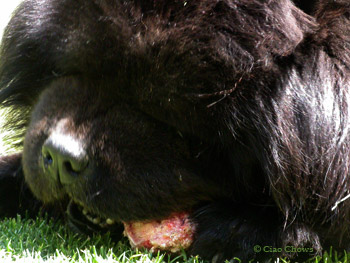 PLEASE
NOTE: Homes of both chow chows & children should take particular note
that certain substances fed to dogs (often unbeknownst to owners)
will kill your dog. Be particularly careful of things like chocolate,
nuts, raisins, non-nutritive sweeteners, cooked chop bones, tinfoil,
etc. Parties and social functions are particularly reknown for careless
and unnoticed damage done to dogs. The canine body cannot cope with
a number of products safe for human use. These products will cause
organ damage - such as renal/liver/heart failure, and too often
results in painful death. If you wish your dogs to be present at
parties & social functions, please provide proper supervision
& make sure all adults & children are educated.
PLEASE
NOTE: Homes of both chow chows & children should take particular note
that certain substances fed to dogs (often unbeknownst to owners)
will kill your dog. Be particularly careful of things like chocolate,
nuts, raisins, non-nutritive sweeteners, cooked chop bones, tinfoil,
etc. Parties and social functions are particularly reknown for careless
and unnoticed damage done to dogs. The canine body cannot cope with
a number of products safe for human use. These products will cause
organ damage - such as renal/liver/heart failure, and too often
results in painful death. If you wish your dogs to be present at
parties & social functions, please provide proper supervision
& make sure all adults & children are educated.
video guides:
Activities for Chows:
More Guides:
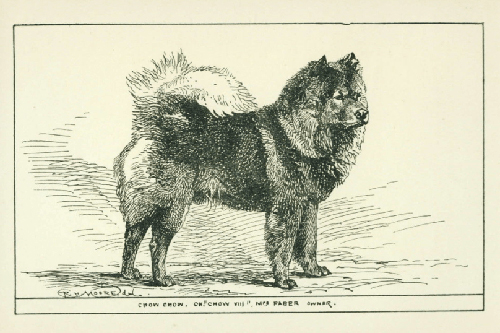 Learn more about the Chow Chow upon which the Breed standard is said to have been based.
Learn more about the Chow Chow upon which the Breed standard is said to have been based.
Learn about the Chow Chow's rich history on the Chow Chow Archives. This will help you understand the need for functional structure and moderate type.
